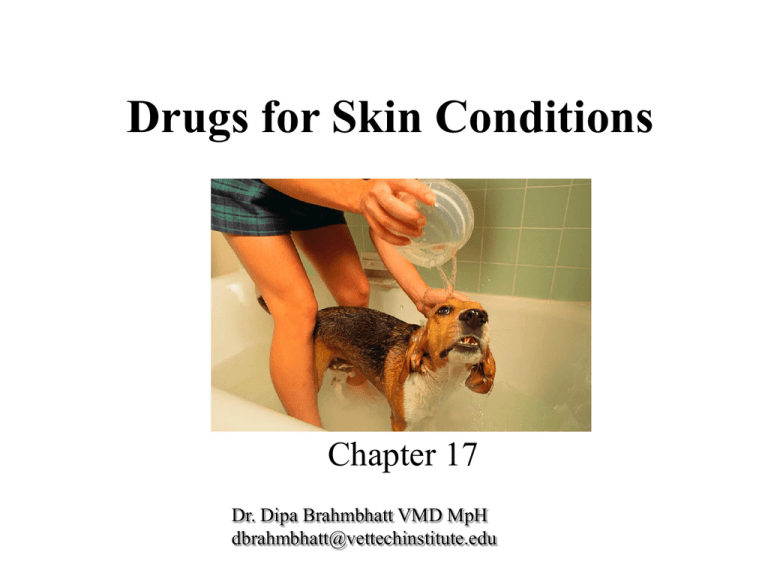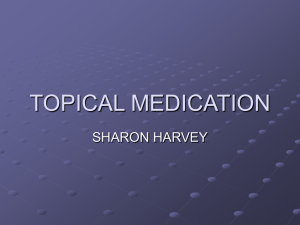Drugs for Skin Conditions - Dr. Brahmbhatt`s Class Handouts
advertisement

Drugs for Skin Conditions Chapter 17 Dr. Dipa Brahmbhatt VMD MpH dbrahmbhatt@vettechinstitute.edu Basic Anatomy & Physiology • The skin is made up of three layers: – Epidermis (the most superficial layer that contains cells, but not blood vessels) – Dermis (the middle layer that is composed of blood and lymph vessels, nerve fibers, and the accessory organs of skin such as glands and hair follicles) – Hypodermis (subcutaneous - the deepest layer that is composed of connective tissue) - fat Basic Anatomy & Physiology Roles of Skin • • • • • First line of defense in immunity (physical barrier) Waterproofing the body Preventing fluid loss Vitamin D synthesis Sebaceous glands lubricate skin and discourage bacterial growth on surface • Sweat glands regulate body temperature and excrete wastes through sweat • Hair controls heat loss and is a sense receptor • Nails, hooves, and claws protect the surface of the distal phalanx Drugs Used in Treating Skin Disorders • Topical treatments consist of agents applied to a surface; they affect the area to which they are applied – Topical antibiotics and antifungals are covered in Table 17-1 in your textbook • Systemic treatments consist of drugs given systemically that affect many areas of the body Drugs Used in Treating Pruritus • Pruritus: itching, may be associated with many skin and systemic diseases • Topical antipruritics provide moderate relief of itching • Usually used in combination with systemic medications such as antihistamines and corticosteroids • Some products listed in other categories may have antipruritic effects, but control of itching is not their main function. Nonsteroidal Topical Antipruritics • Local anesthetics inhibit the conduction of nerve impulses from sensory nerves, thereby reducing pain and pruritus. • They are generally used topically to minimize discomfort associated with allergies, insect bites, and burns. • Poorly absorbed from intact skin, but can be absorbed through damaged skin. • Examples include: lidocaine, tetracaine, benzocaine, and pramoxine Nonsteroidal Topical Antipruritics • Soothing agents/Colloidal Oatmeal Shampoos – Oatmeal has soothing and anti-inflammatory effects when applied topically. Nonsteroidal Topical Antipruritics • Antihistamines are antipruritics that provide temporary relief of pain and itching associated with allergic reactions and sensitive skin. • Products containing diphenhydramine and oatmeal calm itching and soothe irritated skin. Topical Corticosteroids • Topically applied steroids are very effective. They have anti-inflammatory, antipruritic, and vasoconstrictive action. • When applied to skin, they interfere with normal immune responses and reduce redness, itching, and edema. • They also slow the rate of skin production; hence slowing healing time of wounds. • Damaged skin at application site may increase the amount of drug absorbed into the bloodstream and result in systemic side effects. Topical Corticosteroids • The least potent topical corticosteroid is hydrocortisone. • Topical steroids containing a fluorine atom are among the most potent (fluocinolone) • Classified according to duration of action (shortacting, intermediate-acting, long-acting) • Frequently combined with other ingredients such as antibiotics to broaden their action. Topical Corticosteroids • Products include: Gentocin Topical Spray® (betamethasone and gentamicin), Vetalog Cream® (triamcinolone) Antibiotic/Corticosteroid Drugs Used in Treating Pruritus • Topical antipruritics provide moderate relief of itching (may be used with systemic medication) – Topical nonsteroidal antipruritics • Local anesthetics such as lidocaine, tetracaine, benzocaine, and pramoxine – Soothing agents • Oatmeal has soothing and anti-inflammatory effects – Antihistamines • Products containing diphenhydramine calm pain and itching due to allergic reactions and sensitive skin – Topical corticosteroids • Variety of products such as hydrocortisone, fluocinolone, triamcinolone, and betamethazone Seborrhea • Seborrhea is characterized by abnormal flaking or scaling of the epidermis and may be accompanied by increased oil production (seborrhea oleasa) or not (seborrhea sicca) – Accelerated skin cell turn-over with or without excessive sebum production. Seborrhea Keratolytics • Keratolytics are an important group of antiseborrheics – Keratolytics remove excess keratin and promote loosening of the outer layers of the epidermis – Keratolytics break down the protein structure of the keratin layer, permitting easier removal of this material – Found in medicated shampoos to help in treatment of seborrhea Keratolytics • Sulfur: keratolytic, antipruritic, antibacterial, antifungal, and antiparasitic. – It is nonirritating and nonstaining – Used to treat seborrhea sicca – Sebolux Shampoo® – SebaLyt Shampoo® Keratolytics • Salicylic acid: keratolytic, antipruritic, and antibacterial – Used to treat seborrhea sicca and hyperkeratotic skin disorders – Keratolux Shampoo® – SebaLyt Shampoo® Keratolytics • Coal tar: keratolytic and degreasing – Irritating and may stain light-colored haircoats. – Used to treat seborrhea sicca – May be irritating to cats – NuSal-T® – Mycodex Tar and Sulfur Shampoo® Keratolytics • Benzoyl peroxide: keratolytic, antipruritic, antibacterial, and degreasing – Used to treat seborrhea oleosa, moist dermatitis (Hot-spots), pyoderma, stud tail, and a variety of skin lesions that are moist and/or contaminated with bacteria – Pyoben® gel or shampoo Hot Spots Keratolytics – Selenium sulfide: keratolytic, degreasing, and antifungal • Seborrhea and eczema • May result in subsequent irritation • Seleen Plus Medicated Shampoo® • Selsun Blue® Drugs Used in Treating Seborrhea • Examples of topical antiseborrheics: • Sulfur: keratolytic, antipruritic, antibacterial, antifungal, and antiparasitic • Salicylic acid: keratolytic, antipruritic, and antibacterial • Coal tar: keratolytic and degreasing • Benzoyl peroxide: keratolytic, antipruritic, antibacterial, and degreasing • Selenium sulfide: keratolytic, degreasing, and antifungal Antifungal, Antibacterial • Antifungals: – 2% Miconazole – Dermatophysis – 1% Ketoconazole: Atopic dermatitis complicated with pyoderma & Malassezia, dermaophytosis • Antifungal/ Antibacterial: 2% chlorehexidine, 4% chlorohexidine • Hypoallergenic/antiprurtic: Oatmeal, 1% pramoxine, 1% diphehydramine OTHER AGENTS USED TO TREAT SKIN DISORDERS Astringents Antiseptics Soaks and Dressings Caustics Counterirritants Immunomodulators Retinoids Astringents • Astringents are agents that constrict tissues. • Stop discharge by precipitating protein • Have some antibacterial properties • Used to treat moist dermatitis ; effective against Pseudomonas • Acetic acid, found in ear preparations such as OtiClens® Antiseptics • Substances that kill or inhibit the growth of microorganisms on living tissue • Alcohols are bactericidal, astringent, and cooling • Benzalkonium chloride is antibacterial and antifungal • Chlorhexidine is bactericidal, fungicidal, and partially virucidal • Iodine is bactericidal, fungicidal, virucidal, and sporicidal. • Triclosan is antibacterial. Soaks and Dressings • Substances applied to areas to draw out fluid or relieve itching • Aluminum acetate (Burrow’s solution) is drying and mildly antiseptic. It is used as a soak to relieve itching and inflammatory discharge. • Magnesium sulfate (found in Epsom salts) is used in wound dressings to draw fluid out of tissues. Caustics • Substances that destroy tissue • Used to treat warts and excessive granulation tissue (“proud flesh” in horses) • Include Silver Nitrate Stick Applicators® and Equine HoofPro® – Note: Silver nitrate products will stain Proud Flesh Counterirritants • Substances that produce irritation and inflammation in areas of chronic inflammation • Contain alcohol, camphor, menthol, iodine, and/or witch hazel • Thought to increase blood supply to the area, which in turn brings WBCs, antibodies, etc. to are to stimulate healing and carry away kinins to relieve pain. Other Agents Used to Treat Skin Disorders • Astringents are agents that constrict tissues • Antiseptics are substances that kill or inhibit the growth of microbes on living tissue • Soaks and dressings are substances applied to areas to draw out fluid or relieve itching • Caustics are substances that destroy tissue • Counterirritants are substances that produce irritation and inflammation in areas of chronic inflammation Immunomodulators • Substances that have an effect on the immune system • Either immunostimulatory or Immunosuppressive Imiquimod (Aldara®) • Stimulates patient’s monocytes and macrophages to induce regression of viral protein production • Used to treat squamous cell carcinoma, feline herpes viral dermatitis, and localized solar dermatitis. Tacrolimus (Protopic®) & Pimecrolimus (Elidel®) • Inhibits T-lymphocyte activation. • Used to treat atopic dermatitis, lupus erythematosus, pemphigus erythematosus or foliaceous and perianal fistulas Retinoids • Stimulate cellular mitotic activity • Used to treat chin acne, callous pyoderma, and footpad hyperkeratosis Retinoid Uses








